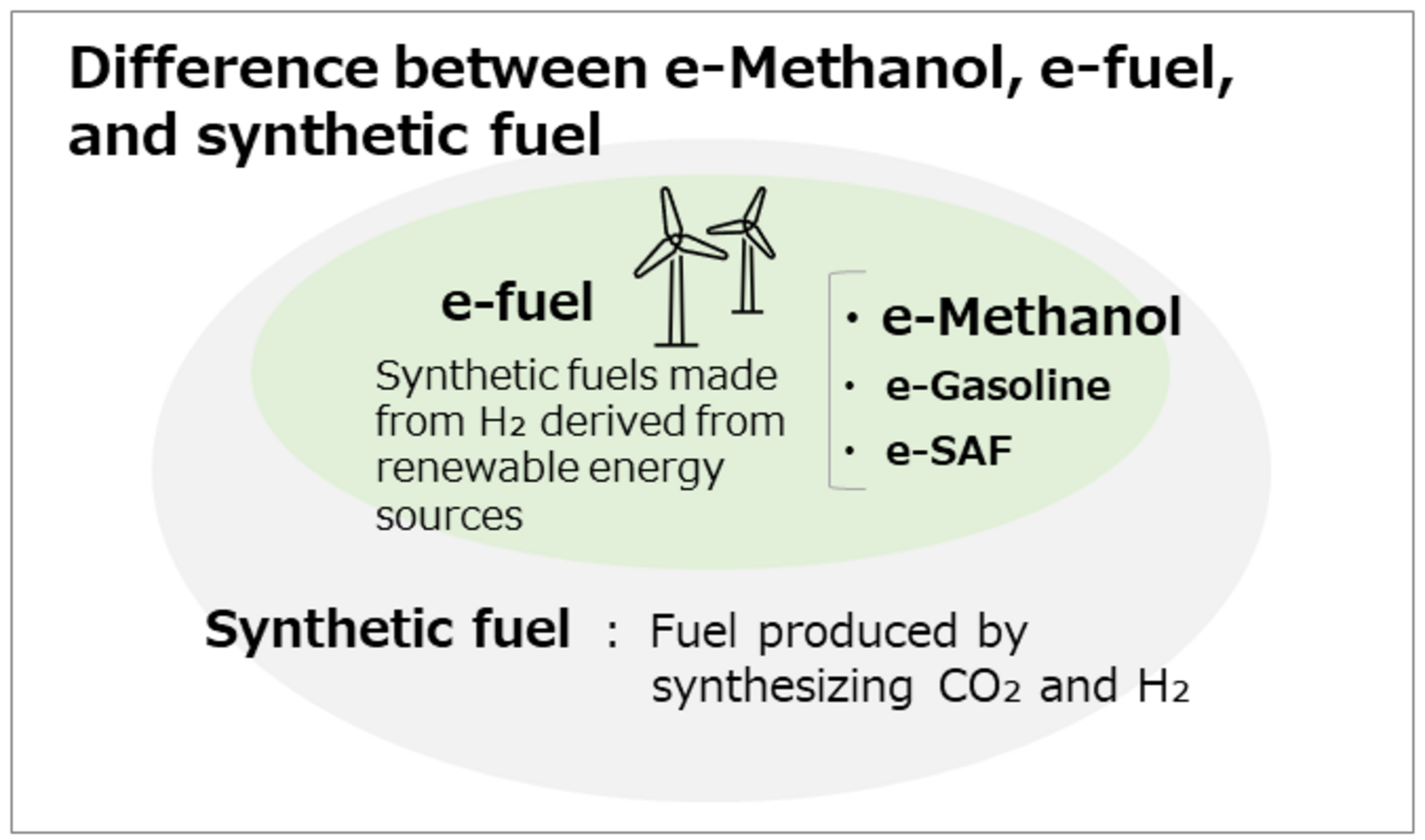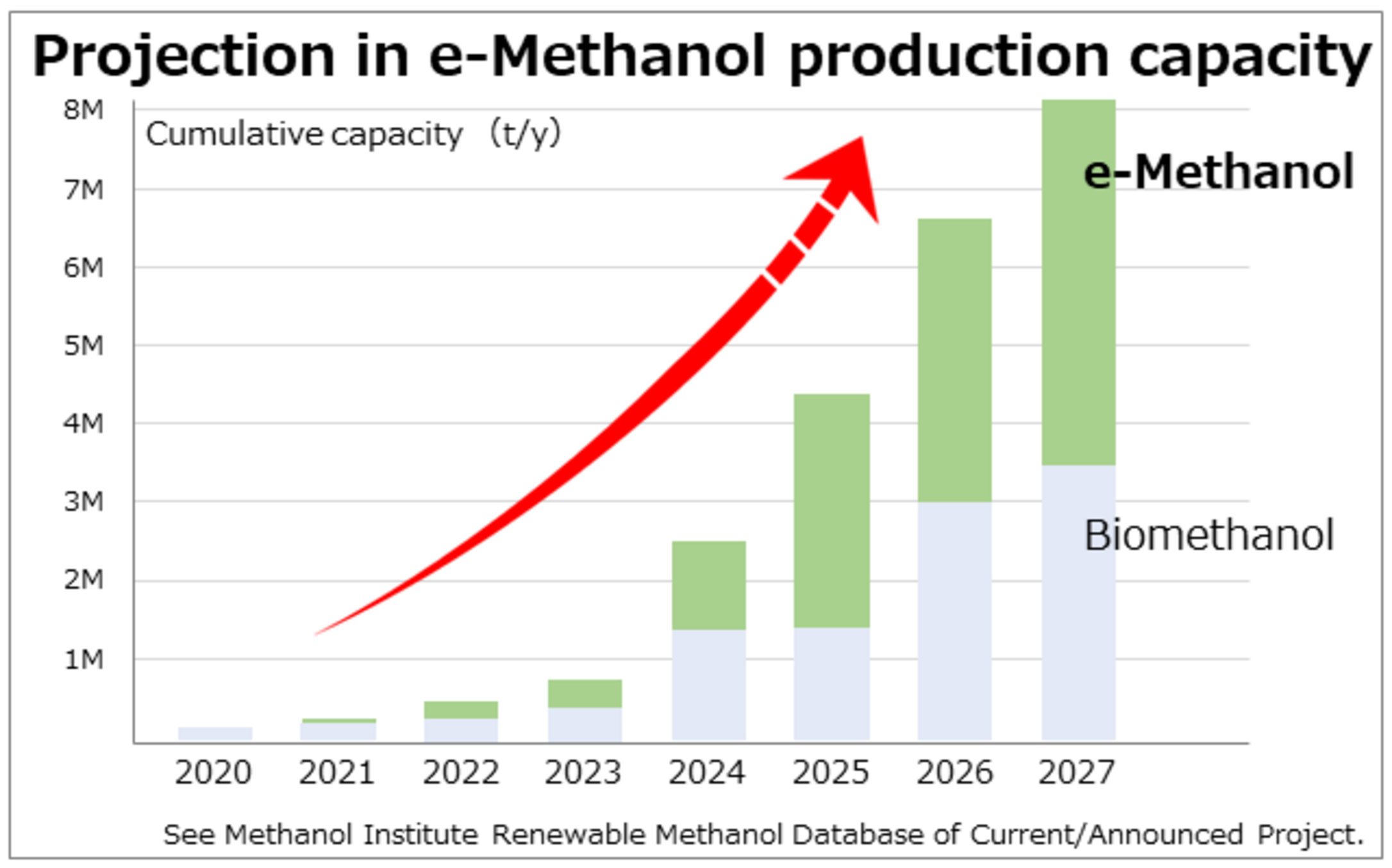A one-minute guide to the future possibilities of "e-Methanol"
As part of efforts to realize a carbon-free society, Idemitsu is taking on the challenge of manufacturing and supplying "e-Methanol". While there are many efforts to "not emit" or "reduce" carbon dioxide emissions, "e-Methanol" is a dream-like next-generation fuel that uses carbon dioxide as a raw material.
We will provide an easy-to-understand explanation of "e-Methanol", which is still not well known.
Q1. What is e-Methanol, which is currently attracting attention? How is it produced?
A. e-Methanol is a low-carbon energy source obtained by synthesizing hydrogen (H₂) derived from renewable energy sources and carbon dioxide (CO₂).






e-Methanol is a type of synthetic fuel, a liquid fuel made by synthesizing H₂ (green hydrogen) produced by splitting water using electricity obtained from renewable energy sources, and CO₂ captured from the atmosphere. synthetic fuel made from renewable energy-derived H₂ are called "e-fuels," and in addition to e-Methanol, there are e-Gasoline and e-SAF.
Conventional methanol is produced using natural gas as a raw material, so expectations are high for e-Methanol, which is produced without using fossil fuels.
●e-Methanol is a fuel that recycles CO₂



Synthetic fuel such as e-Methanol emit CO₂ when used as fuel. However, because they use H₂ generated from electricity derived from renewable energy sources and CO₂ captured from the atmosphere as raw materials, they hardly increase the amount of CO₂ in the atmosphere. For this reason, they are attracting attention as an energy source that can greatly contribute to the realization of decarbonization.
Q2. What is the increase in demand for e-Methanol and what are its future prospects?
A. As demand for Methanol as a whole increases, the production capacity of e-Methanol is expected to expand.
It has been reported that CO₂ emissions from international shipping are greater than those from international aviation, and are equivalent to the emissions of the entire country of Germany as of 2020. The replacement of fuel from liquefied natural gas to methanol, which has lower CO₂ emissions, is progressing, mainly on container ships, and in July 2023, bio-methanol fuel was supplied for the first time in Singapore.



Expectations are rising for green methanol *1, which is produced without using fossil fuels, and global production capacity is expected to expand over the next five years.
-
1. Green Methanol: A general term for e-Methanol and bio-Methanol, which are produced without using fossil fuels.
Q3. What are the benefits of introducing e-Methanol?
A. In addition to being environmentally friendly, e-Methanol also has the advantage of being highly versatile and allowing for the repurposing of infrastructure.
● By reforming it, it can be used as other fuels. Highly versatile



Not only can e-Methanol be used as a marine fuel, but it can also be used to produce jet fuel, gasoline, chemical raw materials, etc. Therefore, it can contribute to decarbonization not only in the shipping industry but also in many other sectors.
- Costs can be kept low by utilizing existing infrastructure
Cost is an obstacle to the widespread use of next-generation fuels. e-Methanol can be handled as a liquid at room temperature and pressure, making it easy to store and transport, and existing infrastructure such as Methanol tanks and pipelines can be used as is. The widespread use of e-Methanol is expected not only because it is easy to keep costs down, but also because it can be smoothly introduced into the market.
Q4. What are the future developments for provide for society and what strengths can Idemitsu utilize?
A. We will jointly invest in HIF Global with JOGMEC to accelerate our efforts to build a supply chain.
●What are Idemitsu's strengths?
In introducing not only e-Methanol but also e-Gasoline and e-SAF to the market, we will be able to utilize the technology and knowledge we have cultivated in the Petroleum business regarding liquid fuels and internal combustion engines. In addition, while cost is cited as an issue with next-generation fuels, we will be able to utilize our existing facilities for the tanks and pipelines required for transportation, storage, and supply.
●Future Prospects
We are considering starting to procure e-methanol or synthetic fuel from overseas projects of HIF Global, Inc. *2, targeting the second half of the 2020s. Furthermore, through our investment in HIF in May 2024, we will promote the production and development of e-methanol and synthetic fuel at overseas bases, while at the same time acquiring knowledge and know-how from HIF's manufacturing projects.
In August 2024, HIF's investment will be switched to a joint venture with JOGMEC (Japan Oil, Gas and Metals Resources Corporation), and the company will accelerate the creation and introduction of markets for e-methanol and synthetic fuel while deepening collaboration with government agencies. In addition to procuring e-methanol overseas from HIF, the company is also considering manufacturing e-methanol in Hokkaido, and aims to build an annual supply system for e-methanol of 280,000 tons by 2030. *3
-
2. HIF Global: A world-leading company promoting projects to convert hydrogen into synthetic fuel based on low-cost renewable energy and that can be transported and used using existing infrastructure.
-
3. As of June 9, 2025
Idemitsu's Goals and Actions for 2050
We introduce Idemitsu's challenges in the area of Energy one step ahead such as synthetic fuel, SAF, ammonia, and hydrogen.